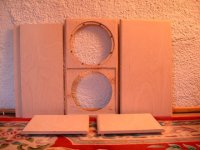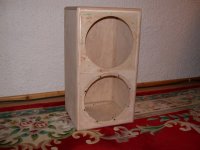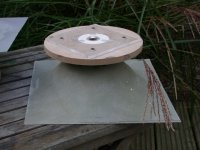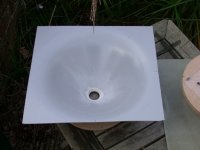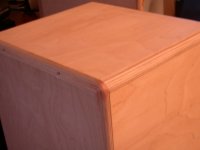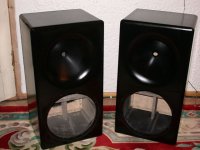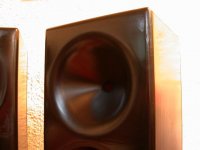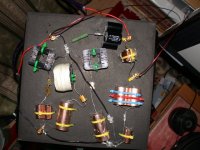The (almost) starting point - 18mm Baltic Birch cut to size, rebate/hole for bass unit cut, hole for the Waveguide cut and rebated (my hand slipped a little - next time I do anything like that I will make a jig/template to keep the router inside the area). My method of construction always uses battens - just visible in the tops (on the floor!)
Attachments
The plywood is a nice look, and I do like it for enclosures. However, in Earl's defense, there are lots of reasons to use MDF over plywood, and cost is not the only one. If anything, I would prefer that the only thing made of plywood be the rear panel and internal baluns (Oak for the baluns would be better yet). It's also really hard out here to get good plywood. I find the stuff for sale at local stores is crap, and shouldn't even be allowed to be called baltic birch ply.
Very nice work though, and I do also like the look. I like your choice of crossover components. I've used those same obligato caps in some of my tube amps, and I do like the sound and quality of construction. I've never used them in a speaker crossover before, but I'm sure they are quite good. While it's not a big deal (it won't hurt anything), large gauge inductors used in the LCR's is not necassary. What guage did you use? What's the DCR of the woofer's series inductor? What type was it again?
Very nice work though, and I do also like the look. I like your choice of crossover components. I've used those same obligato caps in some of my tube amps, and I do like the sound and quality of construction. I've never used them in a speaker crossover before, but I'm sure they are quite good. While it's not a big deal (it won't hurt anything), large gauge inductors used in the LCR's is not necassary. What guage did you use? What's the DCR of the woofer's series inductor? What type was it again?
Plywood or MDF, about the same to me, only MDF is a lot cheaper than good plywood. But your right Matt, its very hard to find good plywood and that makes MDF the better choice. I could do a custom cut of the cabinets in plywood, but it would have a big cost impact. And once painted, whats the difference.
I find plywood to require more work to get a smooth paint job on, but that could just be me. I've also been told that you often have more waste and more bad pieces when cnc routing plywood cabinet pieces, but that might of been an excuse from the company.
as for why I would prefer either plywood or oak for the internal balun pieces is simply that mdf strips rather easily, and I prefer to mount something like the rear panel into a piece that is more solid.
as for why I would prefer either plywood or oak for the internal balun pieces is simply that mdf strips rather easily, and I prefer to mount something like the rear panel into a piece that is more solid.
No argument on the thread stripping. But what I always do is after the first time I use a thread in MDF, I fill it with a few drops of Cyanoacrylic and I never have a problem. The glue soaks into the MDF and hardens the threads - no more stripping. You also have to screw into MDF through the face and never into the edge. So make sure and mount the baluns for the back so that this is true. Fill the holes with the glue and its as good as plywood. Pilot holes are also always required of the wood will split.
By the way, did you woofers have pilot holes? I thought that I did do all three.
By the way, did you woofers have pilot holes? I thought that I did do all three.
Re: Re: Re: Re: Lurker with Abbey Clones
That works very well for me - thanks. There is such a sense of ease with these speakers - they are growing on me daily.
Alan
gedlee said:
Alan
I suggest you try 45 degrees as this is what I do, and I find that about 6 feet back from the crossing point works well.
That works very well for me - thanks. There is such a sense of ease with these speakers - they are growing on me daily.
Alan
no only one speaker had pilot holes. I will get it figured out, no worries. I mean, if you have a template to send me, that would be nice. I'm thinking I will place the speaker into the opening upside down, to my markings, and then it will be easier to pull out again, magnet side up.
The weather has finally warmed up into the 20's so I will be do more sanding and filling this weekend. I need to pick up the Zinser bins and a mask still. Probably will try sealing the edges of the back panel tonight with my remaining shellac product.
The weather has finally warmed up into the 20's so I will be do more sanding and filling this weekend. I need to pick up the Zinser bins and a mask still. Probably will try sealing the edges of the back panel tonight with my remaining shellac product.
My occupation requires frequent travel and recently took me to Ann Arbor, MI. As Earl lives in the vicinity, I contacted him to see if he would be available for an audition of his sound system. On very short notice, Earl agreed to accommodate me despite his already established schedule. Thank-you for allowing an audition on very short notice, Earl!
Prior to the audition, Earl showed me the Abbey and Nathan molded waveguides. From the original effort, it is evident Earl has improved the quality of the waveguides. In the current form, I would not hestitate to buy either kit based on the mold quality.
Earl played several musical tracks, most of which I was quite familiar from artists such as Cream and Diana Krall. Not being very eloquent, I will not try to provide a detailed review as one would read in an audiophile magazine. However, I will try to leave my general impressions from an audion of approximately one hour. The most obvious impression: effortless. The high efficiency speakers seamed to easily handle any genre, even at high volume. Detail - it was as if I was hearing the detail I hear in my Etymotic ER-4 in ear monitors, but instead of the sound originating in my head, it was from a large soundstage in front of me. Non-fatigue - Even at higher volumes, I did not fatigue listening to the Summas.
This year I had the opportunity to attend RMA in Denver. While research indicates the memory of hearing is poor, I do not recall be as satisfied with any system present there as I was listening to Earl’s. However, this is an unfair comparison as the hotel rooms were not as optimal as Earl’s home theater.
I look forward to investing in Earl’s kit in the very near future. While there will always be opportunity to improve any system, I think a home system with the Abbeys or Nathan and multiple subwoofers would satisfy me for a long time, particularly considering the cost of entry.
I think the DIY community is fortunate to have several acoustic gurus such as Earl and Danley participating. Thank-you! I would like to also have the opportunity to audition any of the variations of Danley’s designs....
Prior to the audition, Earl showed me the Abbey and Nathan molded waveguides. From the original effort, it is evident Earl has improved the quality of the waveguides. In the current form, I would not hestitate to buy either kit based on the mold quality.
Earl played several musical tracks, most of which I was quite familiar from artists such as Cream and Diana Krall. Not being very eloquent, I will not try to provide a detailed review as one would read in an audiophile magazine. However, I will try to leave my general impressions from an audion of approximately one hour. The most obvious impression: effortless. The high efficiency speakers seamed to easily handle any genre, even at high volume. Detail - it was as if I was hearing the detail I hear in my Etymotic ER-4 in ear monitors, but instead of the sound originating in my head, it was from a large soundstage in front of me. Non-fatigue - Even at higher volumes, I did not fatigue listening to the Summas.
This year I had the opportunity to attend RMA in Denver. While research indicates the memory of hearing is poor, I do not recall be as satisfied with any system present there as I was listening to Earl’s. However, this is an unfair comparison as the hotel rooms were not as optimal as Earl’s home theater.
I look forward to investing in Earl’s kit in the very near future. While there will always be opportunity to improve any system, I think a home system with the Abbeys or Nathan and multiple subwoofers would satisfy me for a long time, particularly considering the cost of entry.
I think the DIY community is fortunate to have several acoustic gurus such as Earl and Danley participating. Thank-you! I would like to also have the opportunity to audition any of the variations of Danley’s designs....
- Status
- This old topic is closed. If you want to reopen this topic, contact a moderator using the "Report Post" button.
- Home
- More Vendors...
- GedLee
- DIY Waveguide loudspeaker kit
